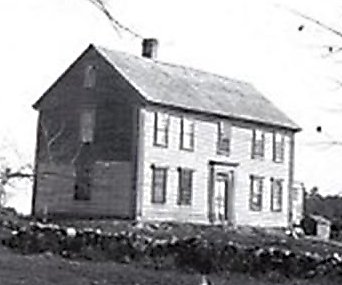Walking Tour 4 - Thoreau's Concord
Some sites walking distance, others best by bike or car; various times.
Henry David Thoreau (1817-1862) was born, lived and died in Concord, Massachusetts. Except for several trips in New England and New York described in his writings, he spent his entire life here.
These are the places he dwelt, lived in, and loved. Most are in the center of Concord, an easy walk. To visit his birthplace at Thoreau Farm and his cabin site and replica at Walden Pond you may want a car or bicycle.
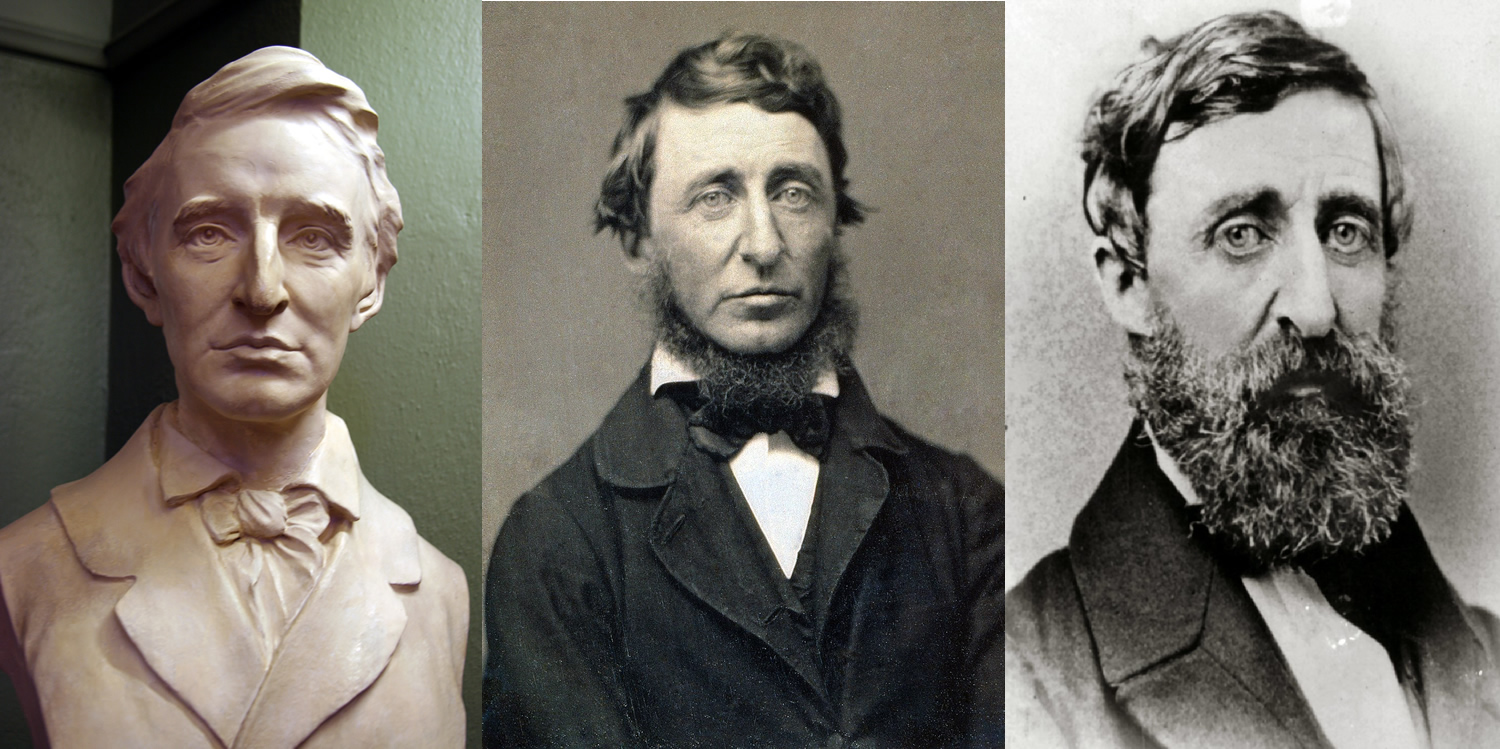
Thoreau Farm - Birthplace
Thoreau was born on July 12, 1817 at what was known as the Wheeler-Minot Farm at 341 Virginia Road, 2.5 miles (4 km) northeast of Monument Square.
He was christened David Henry Thoreau, after a recently deceased uncle. (The last name is pronounced THOR-roh, not thoh-ROH.) He reversed his first and middle name while at Harvard. He liked it better that way.
Built in 1730 by John Wheeler, the farm and its house passed to Henry Thoreau’s ancestor Jonas Minot on his mother’s side.
The house has been changed in many ways through its long history.
Its historic importance recognized, in 1995 it was acquired by the Thoreau Farm Trust, restored, and opened as a museum and cultural center. It’s usually open to visitors on weekends from May through October. More...
Walden Pond
Walden is a kettle pond, formed by glaciers, fed by springs, with no water course entering or leaving it. It is tranquil and deep, kind of like Henry David Thoreau, who came to Concord’s Walden Pond in 1845 “to live deliberately.”
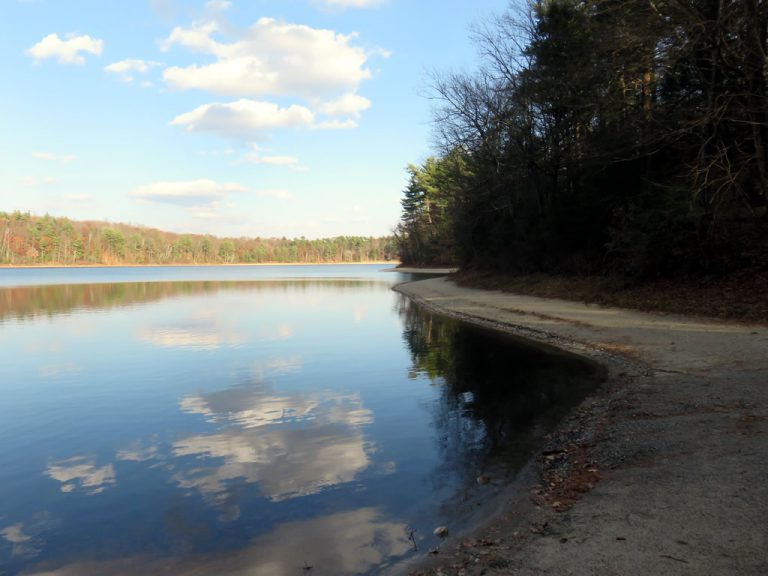
Today Walden is set in Walden Pond State Reservation, a Massachusetts state park offering walking, hiking, swimming, boating and fishing (bring your own boat).
Many people think of Thoreau living off in the forest, far from civilization, but Walden is only 2.3 miles (3.7 km) from Concord's Monument Square, and even less from Emerson's house via the Emerson-Thoreau Amble. Thoreau walked into town frequently, if not daily, and friends would often walk out to Walden to visit him.
Even so, he had the isolation he craved, and the closeness to nature, which helped him to become America's first environmentalist.
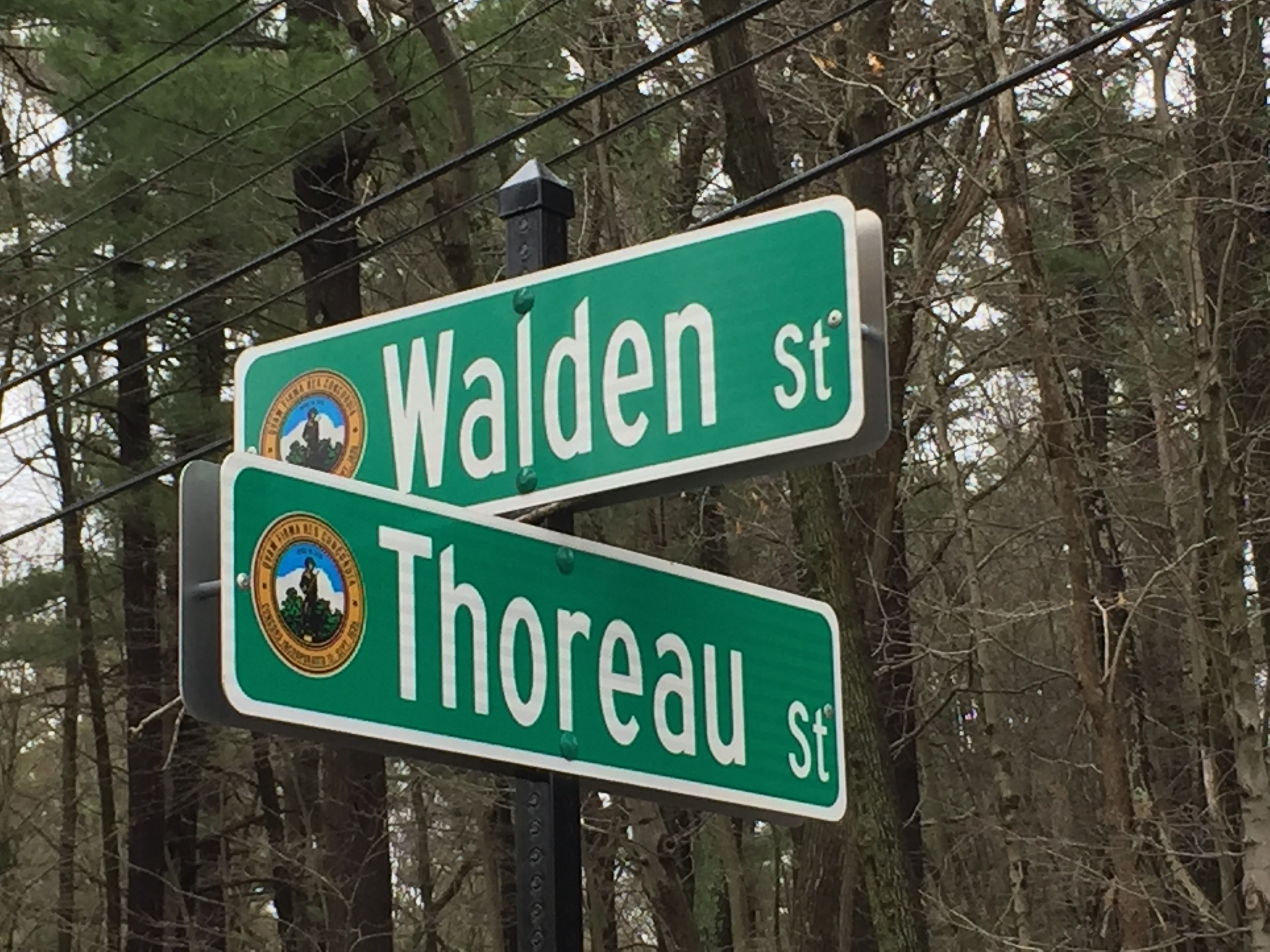
Easy to find your way to Walden Pond!
Replica of Thoreau's House
A replica of Thoreau’s house (he called it that, not a hut or a cabin) is next to the parking lots of Walden Pond State Reservation on MA Route 126 near the intersection of MA Route 2.
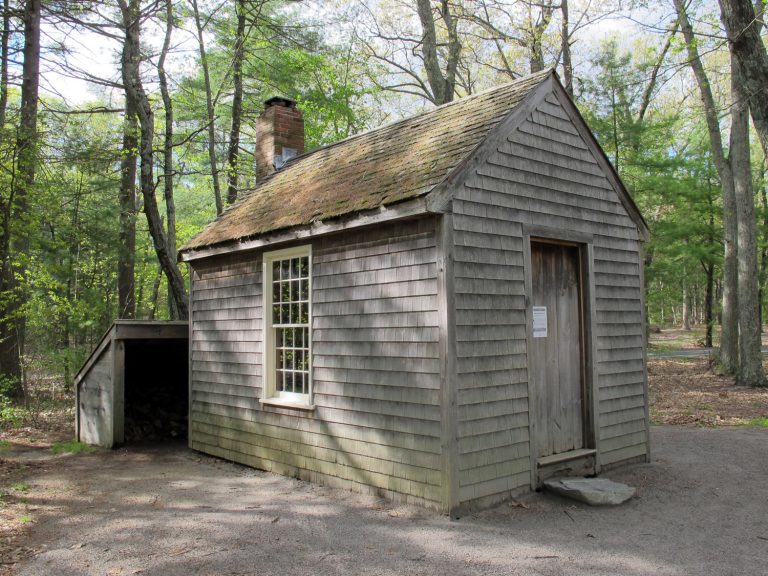
Replica of Thoreau's House near the parking lots at Walden Pond.
Thoreau built the one-story, one-room, 10-foot by 15-foot (3 x 4.6-meter) structure mostly of used materials: old shanty boards; used shingles to cover roof and walls; plaster, lath & horsehair for interior walls; two second-hand windows; and a thousand old bricks for the chimney and fireplace. Total out-of-pocket cost was $28.12-1/2, with the boards, shingles and bricks being over half the cost ($16).
Inside were a bed, table, small desk, lamp, and three chairs: “one for solitude, two for friendship, three for society.”
(For comparison, a Chevy Suburban SUV is 19 feet long—longer than Thoreau’s house!)
Behind the house was a woodbox for firewood.
The replica is usually open to the public during park hours.
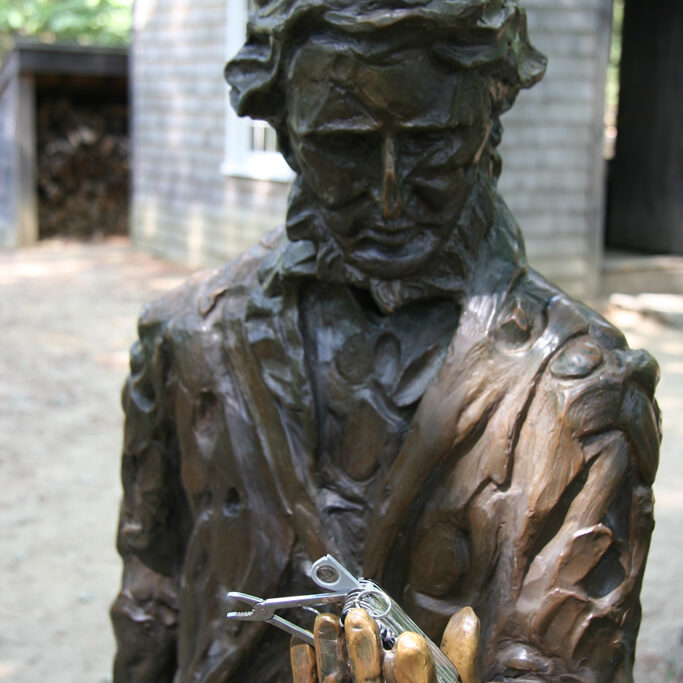
Swiss Army Knife! Would've been useful when I was living here....
Thoreau House Site
The site of Thoreau's little house is 6/10 mile (965 meters) from the Walden Pond Visitor Center, a 12- to 15-minute walk. You can go by the Pond Path along the shore, or by the ACA-compliant Woods Path. Click here to download a trail map.
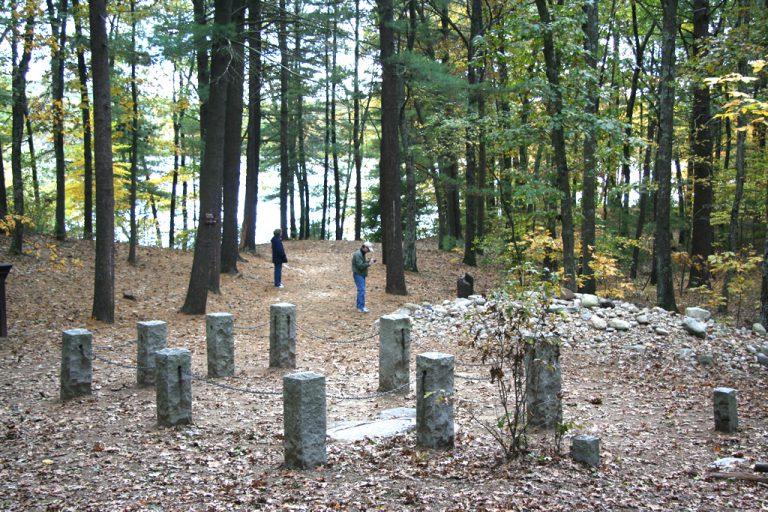
Site of Thoreau's little house on the shore of Walden Pond
The approximate site of Thoreau’s house had been known for years. His old friend, the Concord sage Bronson Alcott (father of Louisa May Alcott) had walked out from Concord in 1872 with a visitor and placed a stone at what he remembered to be the site of Thoreau’s house.
This began the custom, and later visitors—ecological and literary pilgrims, really—also brought stones until the stones formed a substantial cairn.
Exactly a century after Thoreau built his little house and moved here, amateur archeologist Roland Wells Robbins spent three months digging the ground near the cairn until he discovered the footings for the chimney of the house.
Today an inscribed stone marks the place of the chimney, and granite standing stones frame the area the little house covered.
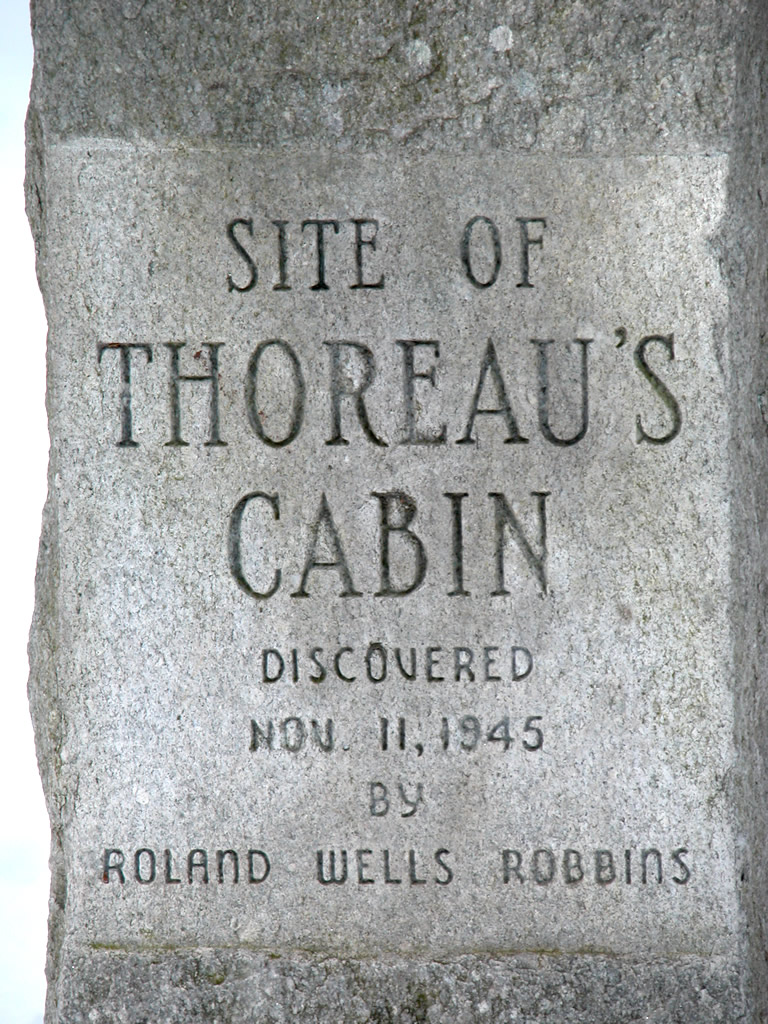
I went to the woods because I wished to live deliberately, to front only the essential facts of life, and see if I could not learn what it had to teach, and not, when I came to die, discover that I had not lived. —Thoreau
Emerson-Thoreau Amble
The Emerson-Thoreau Amble is a footpath recreating the route Ralph Waldo Emerson, Henry David Thoreau, Louisa May Alcott and other Concordians may have followed on walks between Concord MA and Walden Pond. It starts behind the Emerson House and follows a winding route for 1.7 miles (2.74 km) to the site of Thoreau’s house. The walk takes 40 to 60 minutes, one way. Here are a Trail Guide with map, and just the Trail Map.
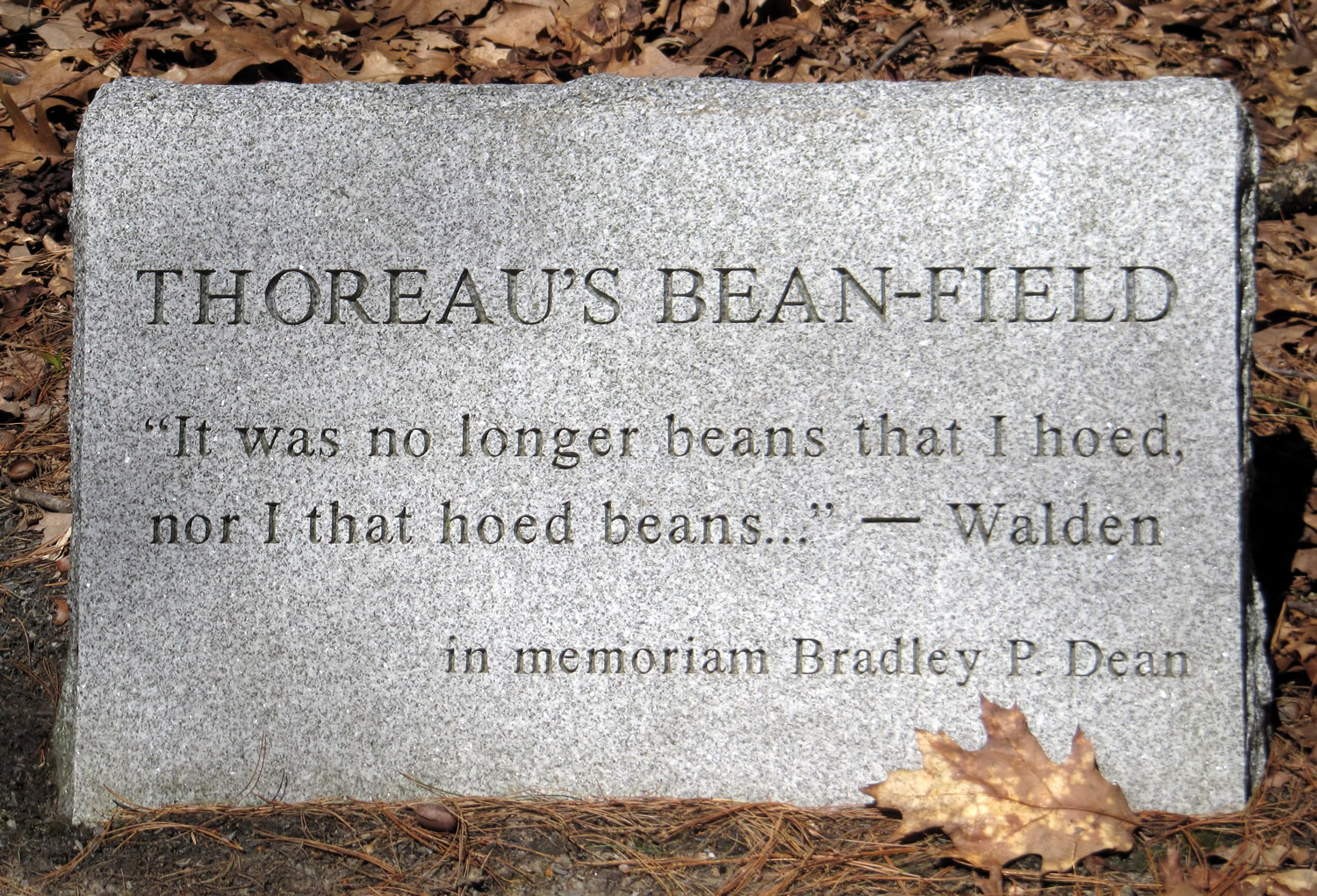
Along the way, you may pass this stone marking Thoreau's bean field.
Thoreau's Path on Brister's Hill
About a mile from Emerson's House along the Emerson-Thoreau Amble is a one-mile (1.2-km) loop trail that wends its way through a corner of Concord's Hapgood Wright Town Forest at the northeast corner of the intersection of MA Routes 2 and 126 (Walden Street). Thoreau's Path on Brister's Hill is open daily for free, but the only parking at the trailhead is for a single Handicapped-tagged vehicle. Other visitors must walk from the Town Forest Fairyland Pond parking lot, 530 yards (484 meters, 7 minutes) to the north on Walden Street, or an equal distance from the lots at Walden Pond State Reservation on Walden Street (Rte 126) to the south. Here's the Town Forest Guide with map, and here's just the Trail Map .
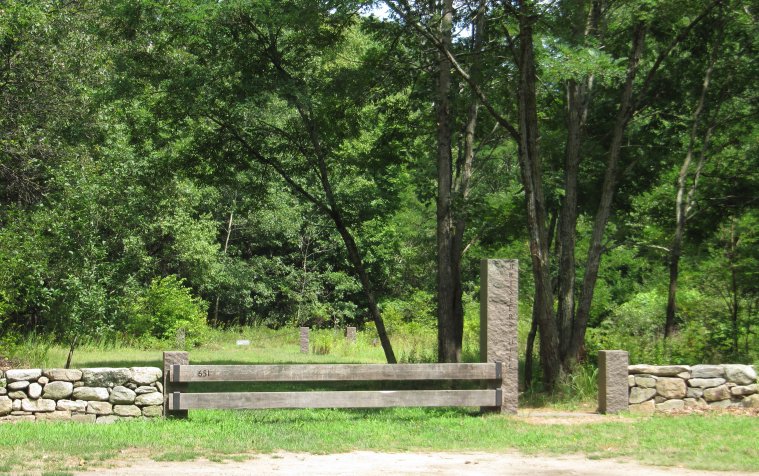
Entrance to Thoreau's Path on Walden Street (MA Route 126) just north of MA Route 2.
The Walden Woods Project, founded in 1990 by recording artist Don Henley, works to to protect and preserve land near Walden Pond that is not part of the Walden Pond State Reservation. Thoreau's Path on Brister's Hill is among its preservation and enhancement projects, protecting land that was slated for office development until Don Henley and others took action to preserve it.

Map of Thoreau's Path on Brister's Hill
Emerson House
Thoreau moved out of his house at Walden Pond in September 1847 and into “Bush,” the Emerson family home, when Ralph Waldo Emerson left for a trip to Europe. He helped Lidian Emerson with house chores, repairs and gardening, and tutored the Emerson children.
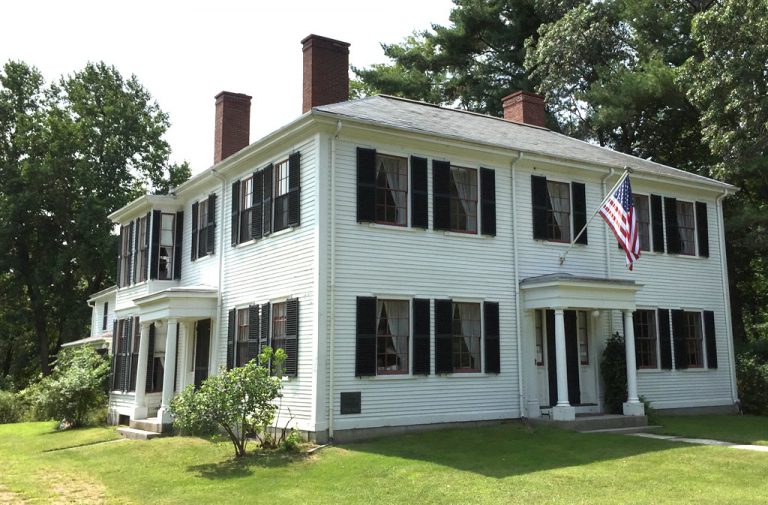
"Bush," the home of Ralph Waldo & Lidian Emerson, and their children.
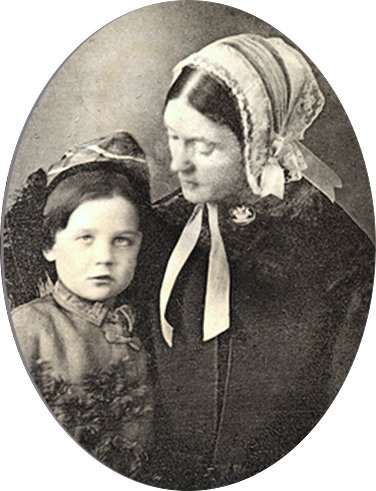
Edward Waldo & Lidian Emerson c. 1848, about the time Thoreau lived with them.
Thoreau-Alcott House
In July 1848, Thoreau moved out of the Emerson house to stay in a house on Belknap Street in Concord. Then, in 1850, he moved around the corner and into the house at 255 Main Street, with others of his family.
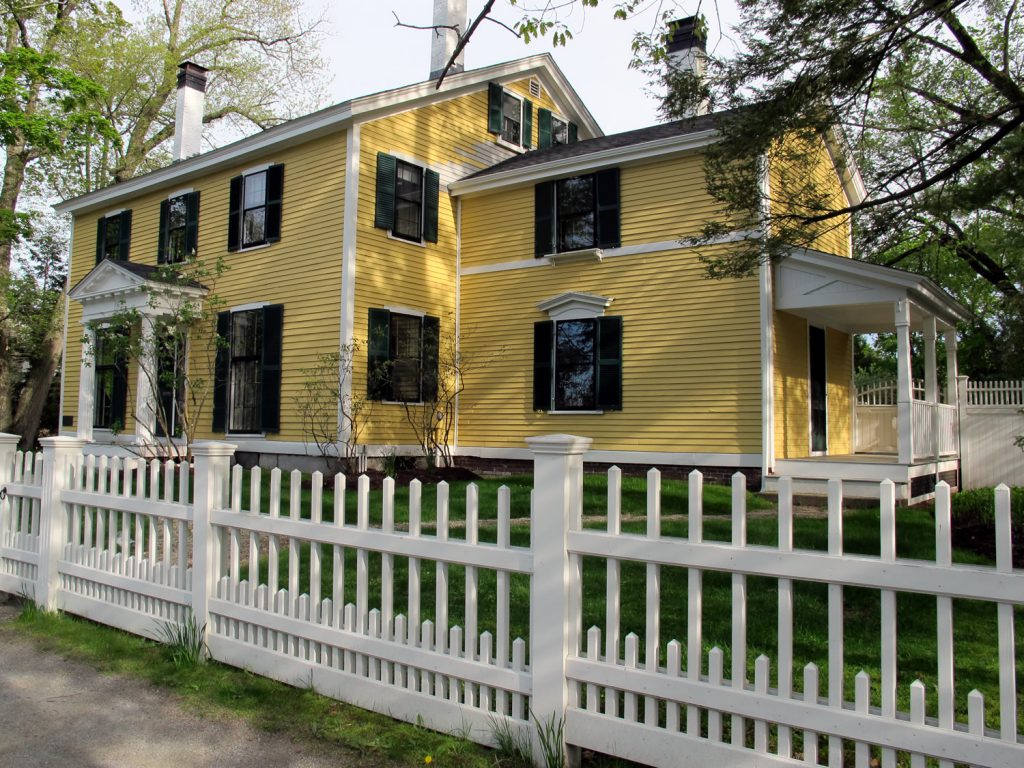
Thoreau-Alcott House, 255 Main St, Concord MA
Built in 1849, the house was his home until his death from tuberculosis in May 1862.
Louisa May Alcott and her sister Anna purchased the house in 1877 after their mother’s death, and they lived here with their father Bronson Alcott.
The house, now a private home not open to visitors, is known as the Thoreau-Alcott House and has been on the National Register of Historic Places since 1976.
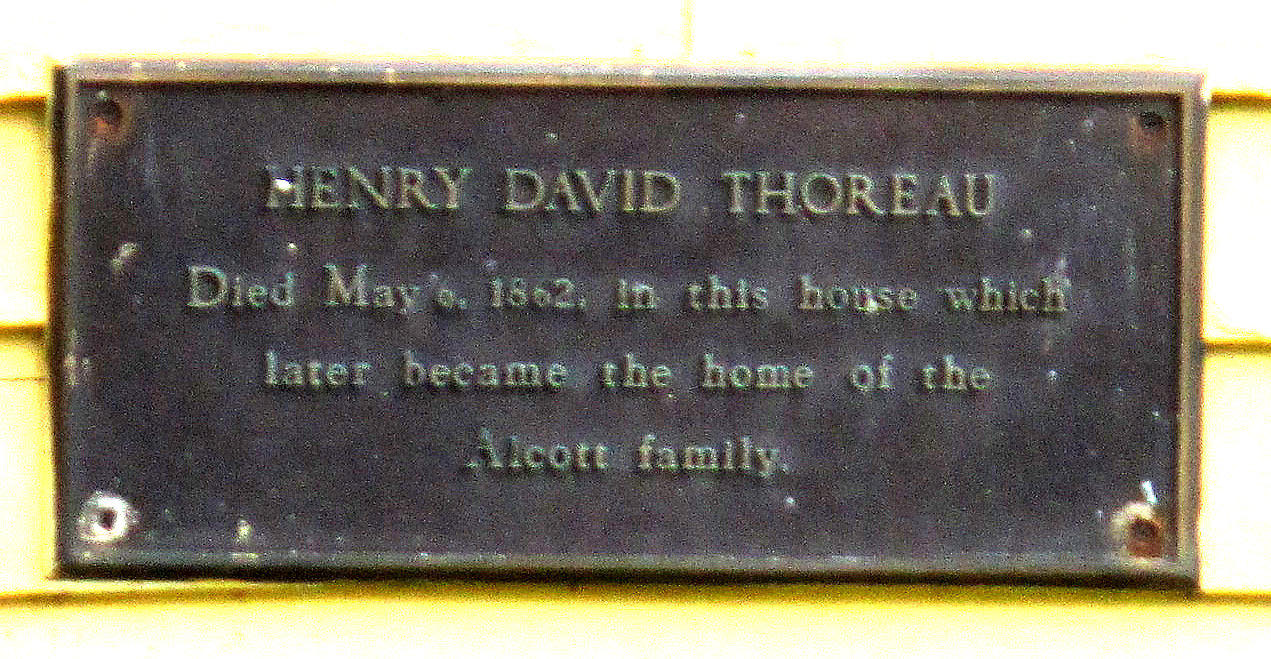
Historic marker on Thoreau-Alcott House: "HENRY DAVID THOREAU Died May 6, 1862, in this house which later became the home of the Alcott family."
Thoreau's Grave
Henry David Thoreau’s grave on Authors Ridge in Concord’s Sleepy Hollow Cemetery is severely plain: just a marble headstone engraved Henry.
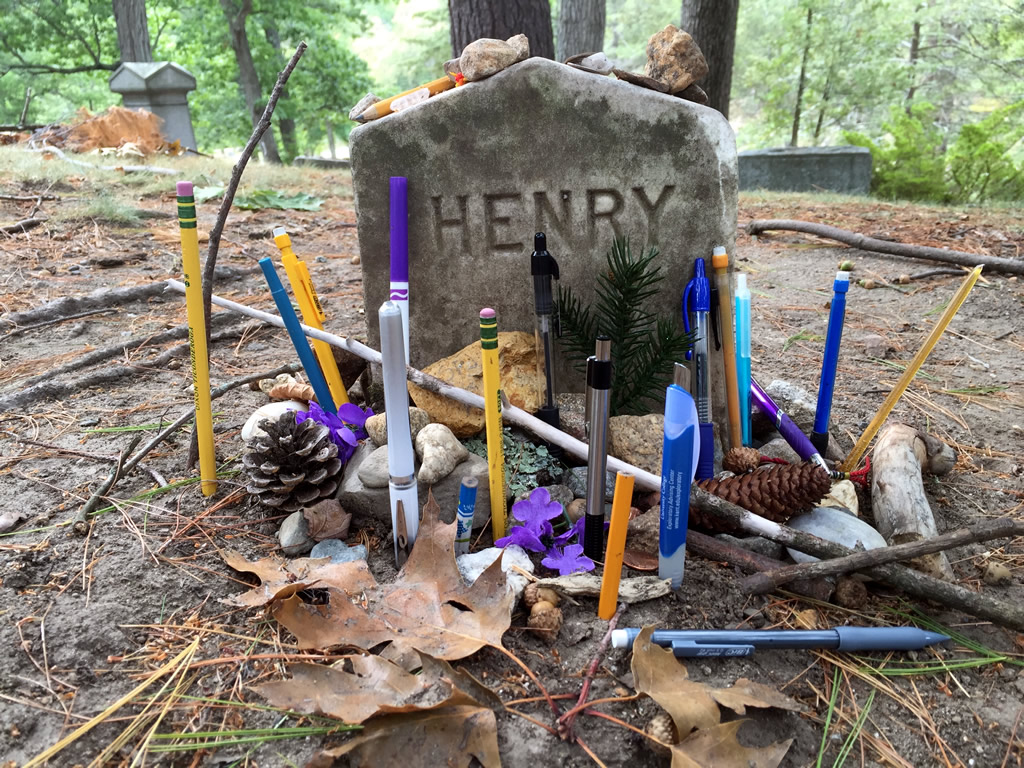
Henry David Thoreau's grave with votive offerings.
But Thoreau looms large in the minds and spirits of thousands of readers, ecologists and plain folks the world over, and for them (or me) a visit to his grave is a special event, summer or winter.
Among the votive offerings it’s common to find pencils, because Thoreau and his father John Thoreau ran a company that developed and manufactured the best pencils in the USA at the time. Pencils supported Thoreau in his studies at Harvard, during his life, and in his literary efforts.
The graves of Bronson Alcott, Louisa May Alcott, Ralph Waldo Emerson and his wife Lidian Jackson Emerson, and Nathaniel Hawthorne, his wife Sophia Peabody Hawthorne and their daughter Una, are all nearby on Authors Ridge.
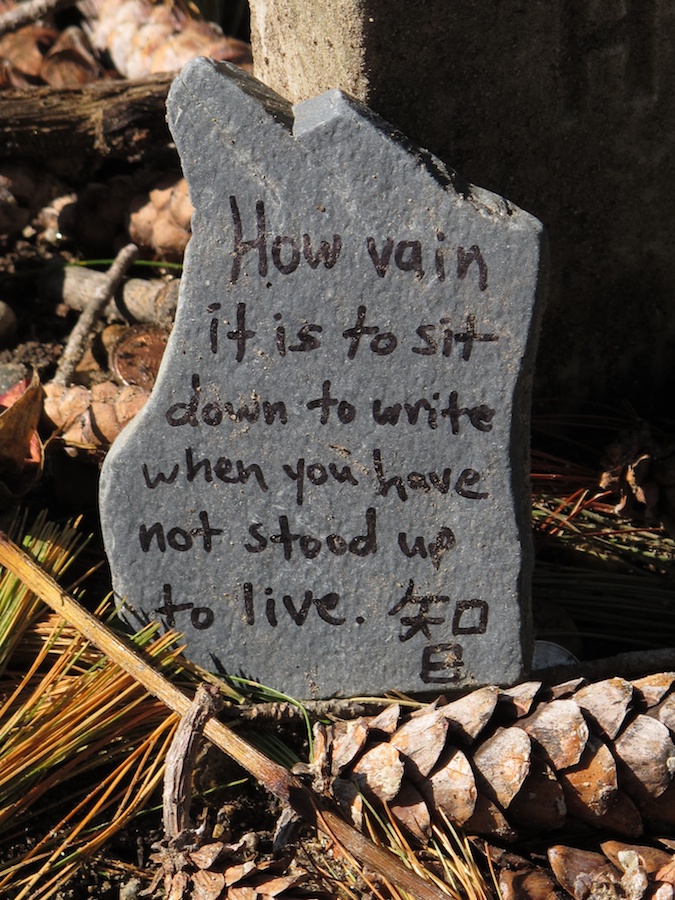
Quotation left as a votive offering: "How vain it is to sit down to write when you have not stood up to live." (Thoreau's Journal, 19 August 1851).

